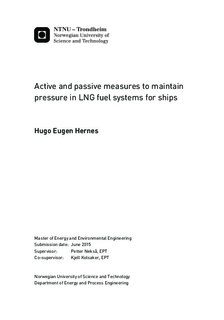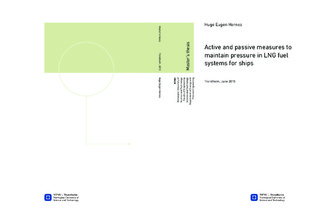| dc.description.abstract | The purpose of this master thesis is to investigate the effects of active and passive measures to maintain the pressure in LNG fuel systems for ships. The background was two de-loading events that occurred on the gas engines on KV Bergen, a Norwegian Coast Guard vessel, in 2012 and 2013. The events triggered research, both on why a sudden large drop in the fuel tank pressure can occur, and how they could be prevented in the future.
The task required development of two models or simulation tools. One model was needed to assess the capacity of the Pressure Build-up Unit (PBU) on KV Bergen, another to analyse different aspects relevant for the pressure development of a fuel tank. Thus, the models had to quantify the drop in pressure, assess the contribution from various parame-ters decisive for the development of the tank pressure, such as relevant tank, LNG system and sea conditions. An inert gas for rapid pressurization of the fuel tank was additionally including in the model. The models are scripted in Matlab and utilize the thermodynamic properties provided by the software REFPROP NIST. The models draw on accessible data for KV Bergen and another LNG fueled vessel, the car-ferry MF Korsfjord.
In the capacity model for the PBU, the principles of the thermosyphon effect are used for calculating the mass flow rate and the return temperature of the LNG. A sensitivity anal-ysis was carried out to evaluate the importance of different parameters on the design ge-ometry and the system configurations of the PBU onboard KV Bergen.
The fuel tank pressure development model consists of the internal energy and the mass balance of the vapor and the liquid sections of the fuel tank. Departing from the basic pressurization capacity with evaporation through the PBU and condensation at the liquid-vapor interface, the model add in-tank waves representing the impact of rough sea, injec-tion of gaseous Nitrogen to achieve additional pressurization capacity, and the use of warm-er LNG to reduce the condensation rate.
The results obtained in this master thesis strongly suggest that an LNG fueled vessel should be capable of ensuring that the bulk LNG in the fuel tank keeps a temperature with a liquid saturation pressure higher than the designed minimum pressure for the gas engines. According to the thermodynamics, it will then no longer be possible for the tank pressure to fall so low that it will cause a de-loading of the gas engines. For KV Bergen, warm LNG at minimum -143.15 °C (130 K) with a liquid saturation pressure of 3.75 bar, is sufficient. The de-loading pressure limit is stated to be 3.6 bar for the gas engines on KV Bergen (DiRenzo 2014a). To obtain warm enough LNG, the fuel can either be heated during the bunkering process or later in the fuel tank by the PBU. The increase for the first approach is negligible compared to the time the PBU needs for heating up a full tank with cold LNG.
A thermal governed PID-controller should be installed in the PBU, ensuring that the LNG is completely evaporated and sufficiently superheated before returned to the fuel tank.
Finally, Nitrogen can be injected into the LNG tank if the PBU for any reason is not capable of maintaining the pressure. As an inert gas, the added Nitrogen does hardly impact the material quality of the LNG, and is thus well suited as a pressurant. | |

